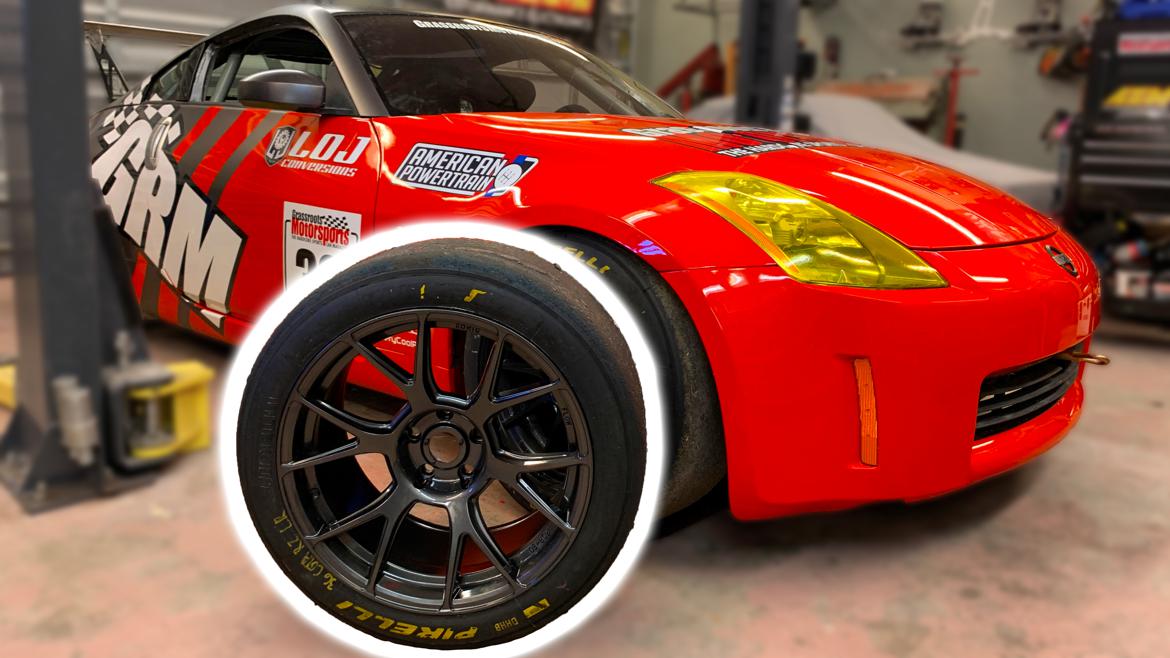

Thanks to our DIY vinyl wrap, our LS-swapped 350Z was now looking like a real race car. Time to make it go like one, which meant getting back on track.
But we weren’t just looking for a fast car. We wanted an easy-to-drive car that was also consistent, adjustable, composed and reliable.
The difference between the race efforts at the Rolex 24 and the ones at your local club race can be measured in cubic dollars, but that money isn’t just spent on fancy uniforms and forged parts. It’s also spent on test days, engineers, and “What if?” wild goose chases that combine to build a giant data set that’s condensed into a top-secret notebook: all the different possible paths to success.
We didn’t have a Rolex 24-level budget, but we knew we didn’t have a chance of joining NASA’s hypercompetitive TT2 field without at least a basic setup book under our arm. That meant it was time to go to the track and start collecting data. We’ll detail that process in the next installment, but first we had one more major item on our shopping list: tires.
[Running in an IMSA race on a grassroots budget]
Tires are the most important part of any race car, and up until now we’d been rolling around on some well-used Falken FK510s left over from our drift event a few years back. NASA’s TT rules allow more power/less weight when running DOT-approved tires, and we estimated our 350Z’s sweet spot would be a tire that slotted into the NASA category “DOT- approved: NASA Section Width 267mm to 282mm.”

Photography Credit: Caleb Kersh
What’s that mean when on the phone with Tire Rack? Say it with us: “Hoosiers! Hoosiers! Hoosiers!”
Hoosier A7 or R7 tires are the de facto standard in this category for a reason, but they come with a caveat: money.
[Ultimate track tire guide | 200tw, 100tw, street-legal track and R-comps]
Remember how we said that we didn’t have a Rolex 24 budget? A set of Hoosiers for our 350Z retails for nearly $1700, and they only last a few heat cycles before falling off the pace.
When the time comes to set our phasers to “kill” and go for a trophy, we’ll suck it up and spend the money. But before we get there, we have a bunch of test days to complete since we’re starting development at the first step.
Yes, it’s important to test on the tires you’ll race on, as so much of a car’s performance is dependent on them. Any data we gather on spring rates, alignment specs, shock settings, etc., would be worthless if we gathered it on completely different rubber. That means we’ll inevitably test on Hoosiers.
But for our first few test days, when we’ll be testing reliability, ergonomics, data capture and gross suspension adjustments, spending $1700 on a set of tires seemed a bit excessive.
So we didn’t.
Instead, we noticed that BimmerWorld sells leftover race tires from its pro racing efforts. These tires won’t help us in time trails–if a car is running true racing slicks, NASA requires carrying more weight and/or less power–but they happen to be radial slicks with grip levels that aren’t that far off the Hoosiers.
[Project BMW M3: How BimmerWorld Grew a BMW Passion Into a BMW Business]
Even better: We’ve heard anecdotes that they’re more durable and withstand more heat cycles without falling off pace. Oh, and did we mention the main reason? BimmerWorld sells them used for $75 each. That price gets you tires in average condition, which means they’ve been used for a session or two.
We ordered two sets of 265/660-18 Pirelli DHHB tires, which just barely fit under our 350Z after some fender rolling. They also just barely fit the NASA 282mm section width template, meaning they should be a suitable analog for the biggest tire we’re allowed to run without a penalty. Racing tires are sized differently than street tires, but these are approximately the same size as a 285/35R18 street tire.




BimmerWorld offers a few other sizes, too–its 305/650-18 slicks fit great on Mustangs, for example. If BimmerWorld doesn’t have the right used slicks for your effort, check out the other used tire dealers advertising in every issue of GRM. You’ll find various sizes, compounds and amounts of wear–some maybe even just mounted but never run–at varying price points, but generally you can expect to pay between 25% and 75% of the tire’s original price.
Since we now had two sets of tires, we also needed a second set of wheels. Slicks are much more fragile than street tires, and we didn’t want to waste valuable track time at the tire shop in the case of a puncture or a flat spot. We ordered a set of 18x10-inch Konig Ampliforms with a 20mm offset. These wheels are half an inch narrower than the Dekagrams we’ve been running on, which we think will save some weight and frontal area without affecting grip levels–but that’s yet another thing we’ll be testing.

Thanks to flow-formed construction, they’re light and strong, too, weighing just 19.72 pounds each. They retail for about $1100/set. At less than 44 pounds per corner, this wheel-and-tire combination represents a sizable weight savings compared to street tires, too.
Our 350Z looked like a race car and was now shod like a race car. Time to see if it performs like one, too. We’ll hit the test track in our next update.
Photography Credit: Chris Tropea
View all comments on the GRM forums
You'll need to log in to post.